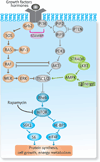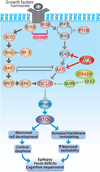Pathogenetic mechanisms of focal cortical dysplasia
- PMID: 24861491
- PMCID: PMC4107035
- DOI: 10.1111/epi.12650
Pathogenetic mechanisms of focal cortical dysplasia
Abstract
Focal cortical dysplasias (FCDs) constitute a prevalent cause of intractable epilepsy in children, and is one of the leading conditions requiring epilepsy surgery. Despite recent advances in the cellular and molecular biology of these conditions, the pathogenetic mechanisms of FCDs remain largely unknown. The purpose if this work is to review the molecular underpinnings of FCDs and to highlight potential therapeutic targets. A systematic review of the literature regarding the histologic, molecular, and electrophysiologic aspects of FCDs was conducted. Disruption of the mammalian target of rapamycin (mTOR) signaling comprises a common pathway underlying the structural and electrical disturbances of some FCDs. Other mechanisms such as viral infections, prematurity, head trauma, and brain tumors are also posited. mTOR inhibitors (i.e., rapamycin) have shown positive results on seizure management in animal models and in a small cohort of patients with FCD. Encouraging progress has been achieved on the molecular and electrophysiologic basis of constitutive cells in the dysplastic tissue. Despite the promising results of mTOR inhibitors, large-scale randomized trials are in need to evaluate their efficacy and side effects, along with additional mechanistic studies for the development of novel, molecular-based diagnostic and therapeutic approaches.
Keywords: Focal cortical dysplasia; Giant cell; Mammalian target of rapamycin; PMSE syndrome; mTOR.
Wiley Periodicals, Inc. © 2014 International League Against Epilepsy.
Conflict of interest statement
None to declare.
Figures



References
-
- Ak H, Ay B, Tanriverdi T, et al. Expression and cellular distribution of multidrug resistance-related proteins in patients with focal cortical dysplasia. Seizure. 2007;16:493–503. - PubMed
-
- Alonso-Nanclares L, Garbelli R, Sola RG, et al. Microanatomy of the dysplastic neocortex from epileptic patients. Brain. 2005;128:158–173. - PubMed
-
- Andre VM, Flores-Hernandez J, Cepeda C, et al. NMDA receptor alterations in neurons from pediatric cortical dysplasia tissue. Cereb Cortex. 2004;14:634–646. - PubMed
-
- Arai Y, Edwards V, Becker LE. A comparison of cell phenotypes in hemimegalencephaly and tuberous sclerosis. Acta Neuropathol. 1999;98:407–413. - PubMed
-
- Aronica E, Boer K, Baybis M, et al. Co-expression of cyclin D1 and phosphorylated ribosomal S6 proteins in hemimegalencephaly. Acta Neuropathol. 2007;114:287–293. - PubMed
Publication types
MeSH terms
Substances
Grants and funding
LinkOut - more resources
Full Text Sources
Other Literature Sources
Medical
Miscellaneous

